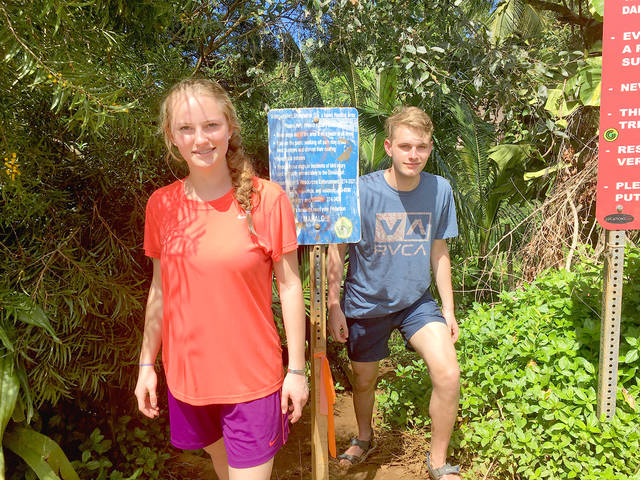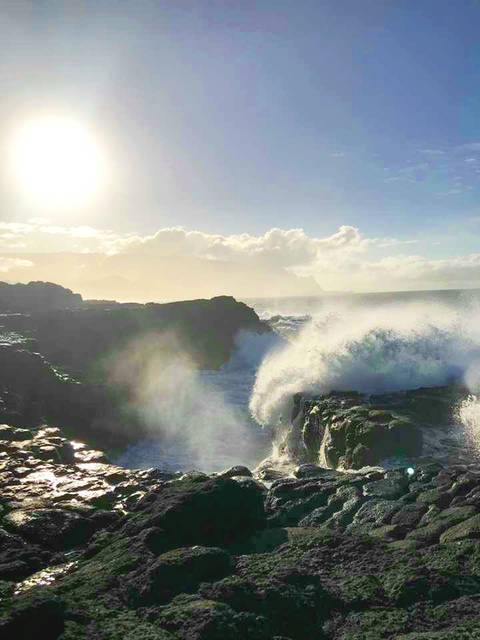Effervescent bubbles float through Queen’s Bath, interrupting pristine views of tropical fish every time a wave crests the lava rock that separates the deep pool from the ocean on Kauai’s North Shore.
It’s beautiful, but the place’s deadly history has kept it off the list of promotable destinations and on the list of places to visit with extreme caution.
In fact, officials say Queen’s Bath is a public space that isn’t promoted or advertised by the county, state or the visitors bureau. Beachgoers are encouraged to visit the island’s guarded beaches, and to heed the county’s ocean reports and high-surf advisories.
“Mostly we’re focusing on closing it when there’s dangerous surf, ideally so nobody could get down there, particularly visitors who are naïve to how dangerous it is,” said Rory Enright, general manager of the Princeville Community Association.
He said the PCA is working with the county to potentially put a gate across the trailhead that could be closed when conditions turn dangerous.
“We are pursuing the option to close the Queen’s Bath trail during dangerous ocean conditions, in partnership with Princeville Community Association, our first responders and other stakeholders,” said Lenny Rapozo, director of the county Department of Parks and Recreation.
Queen’s Bath has been the scene of dozens of deaths over a span of more than 30 years. Generally, the incidents follow the same storyline — someone wasn’t paying attention and a wave snatched them into the ocean.
Most recently, a 51-year-old Kapaa man was airlifted from Queen’s Bath after a wave swept him out to sea while he was picking opihi. The unnamed man was able to return to the rocks on his own and sustained multiple lacerations.
In February 2017, a man was swept out to sea from the ledge as he was taking a picture, leaving behind his wife and young son.
That same year in August, a Milwaukee couple and their 11-month-old baby survived a rogue wave that swept them off the rocks and into Queen’s Bath. Visitors from Oahu and Canada, whom they didn’t know, saved them from the pool with only minor cuts and bruises.
Two California men died in January 2013 when a wave knocked one down and dragged him out to sea — and the other man jumped into the rugged water to try to save him.
In October 2008, three visitors — two women ages 33 and 38 and a man age 74 — drowned after being knocked off a ledge at Queen’s Bath and being swept out to sea. Their bodies were recovered in Hanalei.
Those are just a few of the many dangerous and deadly incidents that have happened at Queen’s Bath. Multiple signs have been erected that are easily seen from the trail, marked with drawings of skulls and crossbones.
And yet, on a recent sunny Wednesday, a steady stream of visitors was flowing in and out of the trailhead.
Some of those people don’t even look at the signs, said Brad Olsen, visiting with his family from Utah, who stopped to talk in the parking lot after a visit to the area.
“Some people don’t pay attention, but don’t close it because of them. It’s good to have a sign there,” Olsen said. “It’s about being responsible about going down there, being prepared, knowing the conditions.”
Kauai is full of dangerous places, he pointed out, and closing off access to them isn’t the way to go. Instead, Olsen advocates responsible traveling and solid educational campaigns for visitors.
“Kauai has quite a lot of dangerous places, I mean look at all the hikes with the ridges,” Olsen said. “You can get hurt on almost any one of them.”
Dr. Monty Downs, president of the Kauai Lifeguard Association, said he doesn’t think closing dangerous beaches is the solution either. Instead, he advises people go to lifeguarded beaches and learn their limits in the water.
“Do I think access to these dangerous beaches should be closed? I don’t. I do, however, think people should be told in no uncertain terms not to go there, and to go only to guarded beaches,” he said.
Social media is causing the opposite to happen, he said, because there’s plenty of information on the beauty of areas like Queen’s Bath, with no warnings about the dangers.
“Try Googling ‘Queen’s Bath,’” he said.
So, the goal is to educate visitors through concierges at resorts, with airport videos, brochures, radio spots, newspaper ads and editorial pieces — basically anything that beach safety officials can think of to raise awareness of ocean dangers.
“We haven’t yet found the means and time to catch everyone, not by a long shot,” said Dr. Monty Downs, president of the Kauai Lifeguard Association.
Deadly waves at Queen’s Bath are just part of the problem for the Princeville community. Traffic is also a problem.
In the winter, cars line the tiny parking lot set aside for hikers next to the trailhead, and sometimes people wait for half an hour on the street for a place to park because the roadsides are lined with “No Parking” signs. And that’s in the off-season.
“It used to be empty in the winter, but now it’s that way all year round,” Enright said. “In the summer when it’s bright and sunny, I don’t have a means of counting how many cars come and go, but it’s a lot.”
•••
Jessica Else, environmental reporter, can be reached at 245-0452 or jelse@thegardenisland.com.








I don’t think Dr. Downs said this…
“Dr. Monty Downs, president of the Kauai Lifeguard Association, said he doesn’t think closing dangerous beaches is the solution either. Instead, he advises people go to lifeguarded beaches and learn their limits in the water.”
LEARN YOUR LIMITS IN THE WATER…even at Lifeguarded beaches, this was not said by Dr. Downs, this a “typo” error. Dr. Downs, we are sure, would say, Don’t go in the water anywhere on dangerous surf days, Lifeguarded or not.
Mahalo,
Charles
At one time, the county was going to improve the trail to the site, saying that the trail was unsafe.
gghmason@hotmail.com. Up here in the Rockies, people duck closed ropes and die in avalanches. They get between mother bears and their cubs trying to take pictures. Tourists seem to leave there brains at home! I applaud the concierge at the Cliffs, who wouldn’t tell me how to get to the bath. She she put the fear of God in me and when I went down there I was very very cautious!! I kept my di
We are regular visitors to Kauai and Queens Bath is one our favorite places to visit – when conditions allow. The signs at the top of the trail and the unimproved trail maybe keep a few out that have no business going down there. It would be great if there was a gate that could be closed when there is high surf for those that don’t pay attention to the conditions. However, you know people will hop the gate just as they do to go to the bottom Wailua Falls, but you cannot fix stupid. And I’m sorry the stupid tourists put your emergency personnel at risk. Thank you to the Princeville Community Assn for taking the initiative to try and keep visitors safe.
Perhaps they could somehow show the ‘prevent drownings’ video on the airplanes before arriving? Having it at baggage claim just doesn’t get the message across, everyone is too distracted to pay attention. Kauai is a beautiful, but potentially deadly place.
I’m a good swimmer who swims most days of the week, but swimming in a pool isn’t swimming in the ocean. And swimming at Queen’s Bath looks like trying to climb out of a washing machine. No thanks. I’d go look at it, but wouldn’t get near it to swim. They definitely need to say “You might die if you decide to swim here or get near the water. We won’t be sending life guards or rescue missions out to save your life or retrieve your body. Swim at your own risk.” Some idiots will still try their luck, but at least they won’t be needlessly risking the lives of rescue personnel for stupid people.
I was down by Queens bath recently and saw them putting a gate up. However i could see obvious ways to get around the gate so i don’t know how effective it will be. There are also other ways to get down to queen’s, but mostly only the locals know those paths so it shouldn’t be too much of a problem to brainless tourists.
What a great analogy of the washing machine!
Couldn’t the government put out a flyer with information on making a good decision when going to the bath? Common sense information to help them navigate the experience? Just something short and sweet that could be quickly absorbed by young and old alike as would be told by someone who has done this many times or a local that knows when it is just too risky? It isn’t always risky otherwise families wouldn’t have great photos showing their kids in the bath. Like days when the water is very calm!